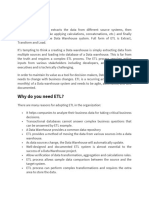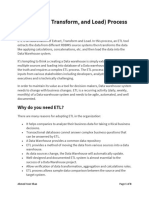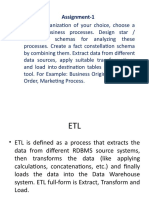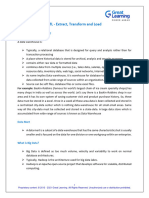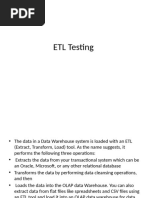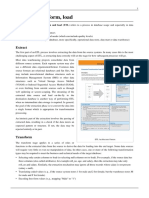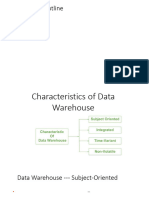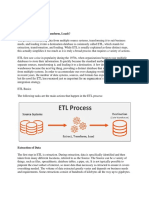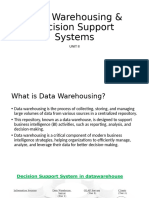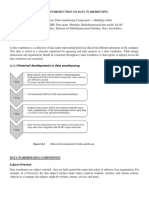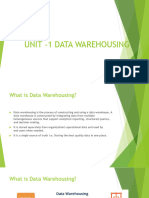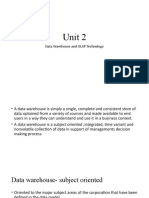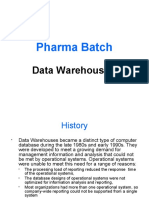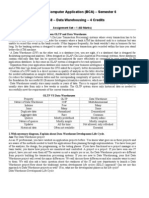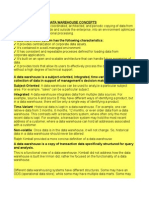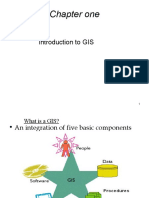0 ratings0% found this document useful (0 votes)
5 viewsbi-unit-3
bi-unit-3
Uploaded by
hamidansari8857Bi unit 3 ppt notes
Copyright:
© All Rights Reserved
Available Formats
Download as PPTX, PDF, TXT or read online from Scribd
bi-unit-3
bi-unit-3
Uploaded by
hamidansari88570 ratings0% found this document useful (0 votes)
5 views26 pagesBi unit 3 ppt notes
Copyright
© © All Rights Reserved
Available Formats
PPTX, PDF, TXT or read online from Scribd
Share this document
Did you find this document useful?
Is this content inappropriate?
Bi unit 3 ppt notes
Copyright:
© All Rights Reserved
Available Formats
Download as PPTX, PDF, TXT or read online from Scribd
Download as pptx, pdf, or txt
0 ratings0% found this document useful (0 votes)
5 views26 pagesbi-unit-3
bi-unit-3
Uploaded by
hamidansari8857Bi unit 3 ppt notes
Copyright:
© All Rights Reserved
Available Formats
Download as PPTX, PDF, TXT or read online from Scribd
Download as pptx, pdf, or txt
You are on page 1of 26
What Is ETL?
Extract Transform Load
ETL is the automated and auditable data
acquisition process from source system that
involves one or more sub processes of data
extraction, data cleaning, data transportation,
data transformation, data consolidation, data
integration and data loading .
ETL
• ETL comes from Data Warehousing and stands
for Extract-Transform-Load. ETL covers a
process of how the data are loaded from the
source system to the data warehouse.
Currently, the ETL encompasses a cleaning
step as a separate step. The sequence is then
Extract-Clean-Transform-Load.
Data Quality
Data quality is a critical factor for the success of data warehousing projects. If
data is of inadequate quality, then the knowledge workers who query the
data warehouse and the decision makers who receive the information cannot
trust the results.
Data quality has to be maintained for individual records or even small bits of
information to ensure accuracy of complete database.
Three powerful forces have converged to put data quality concerns near the top
of the list for executives:
• First, the long-term cultural trend that says, “If only I could see the data,
then I could manage my business better” continues to grow; today’s
knowledge workers believe instinctively that data is a crucial requirement for
them to function in their jobs.
• Second, most organizations understand their data sources are profoundly
distributed, typically around the world, and that effectively integrating a
myriad of disparate data sources is required.
• And third, the sharply increased demands for compliance mean careless
handling of data will not be overlooked or excused.
Data Profiling
• Data profiling is the technical analysis of data to
describe its content, consistency, and structure.
• In some sense, any time you perform a SELECT
DISTINCT investigative query on a database field,
you are doing data profiling.
• There are a variety of tools specifcally designed
to do powerful profiling.
• Data profiling plays two distinct roles: strategic
and tactical.
Data enrichment
• Data enrichment is adding/combining
external data values, rules to enrich the
information already existing in the data.
• Example if we can get a list that provides a
relationship between Zip Code, City and State,
then if a address field has Zip code 06905 it be
safely assumed and address can be enriched
by doing a lookup on this table to get Zip Code
06905 –> City Stamford –> State CT.
Data Deduplication
• Data Deduplication is a process of removing
redundant data. There result of Data Deduplication
is an unique list of values which can be used to
populate data warehouse dimension tables.
• The typical business example would be creating
unique list of customers.
• Data deduplication is a technique for reducing the
amount of storage space an organization needs to
save its data.
ETL architecture
Extract System
• The Extract step covers the data extraction
from the source system and makes it
accessible for further processing. The main
objective of the extract step is to retrieve all
the required data from the source system with
as little resources as possible. The extract step
should be designed in a way that it does not
negatively affect the source system in terms or
performance, response time or any kind of
locking.
There are several ways to perform the extract:
• Update notification - if the source system is able to provide a
notification that a record has been changed and describe the change,
this is the easiest way to get the data.
• Incremental extract - some systems may not be able to provide
notification that an update has occurred, but they are able to identify
which records have been modified and provide an extract of such
records. During further ETL steps, the system needs to identify changes
and propagate it down. Note, that by using daily extract, we may not be
able to handle deleted records properly.
• Full extract - some systems are not able to identify which data has been
changed at all, so a full extract is the only way one can get the data out
of the system. The full extract requires keeping a copy of the last extract
in the same format in order to be able to identify changes. Full extract
handles deletions as well.
Clean
• The cleaning step is one of the most important as it ensures the
quality of the data in the data warehouse. Cleaning should perform
basic data unification rules, such as:
• Making identifiers unique (sex categories Male/Female/Unknown,
M/F/null, Man/Woman/Not Available are translated to standard
Male/Female/Unknown)
• Convert null values into standardized Not Available/Not Provided
value
• Convert phone numbers, ZIP codes to a standardized form
• Validate address fields, convert them into proper naming, e.g.
Street/St/St./Str./Str
• Validate address fields against each other (State/Country, City/State,
City/ZIP code, City/Street).
Transform
• The transform step applies a set of rules to
transform the data from the source to the target.
This includes converting any measured data to
the same dimension (i.e. conformed dimension)
using the same units so that they can later be
joined. The transformation step also requires
joining data from several sources, generating
aggregates, generating surrogate keys, sorting,
deriving new calculated values, and applying
advanced validation rules.
Load
• During the load step, it is necessary to ensure
that the load is performed correctly and with
as little resources as possible. The target of the
Load process is often a database. In order to
make the load process efficient, it is helpful to
disable any constraints and indexes before the
load and enable them back only after the load
completes. The referential integrity needs to be
maintained by ETL tool to ensure consistency.
Change Data Capture System
• During the data warehouse’s initial historic load,
capturing source data content changes is not
important because you load all data from a point
in time forward. However, many data warehouse
tables are so large that they cannot be refreshed
during every ETL cycle.
• The idea behind CDC is to Just transfer the data
that has changed since the last load. But building
a good CDC system is not as easy as it sounds.
The key goals for the change data capture subsystem are:
• Isolate the changed source data to allow selective
processing rather than a complete refresh.
• Capture all changes (deletions, edits, and insertions)
made to the source data, including changes made
through nonstandard interfaces.
• Tag changed data with reason codes to distinguish
error corrections from true updates.
• Support compliance tracking with additional metadata.
• Perform the CDC step as early as possible, preferably
before a bulk data transfer to the data warehouse.
Data Mart
• Data marts contain a subset of organization-
wide data that is valuable to specific groups of
people in an organization. In other words, a
data mart contains only those data that is
specific to a particular group. For example, the
marketing data mart may contain only data
related to items, customers, and sales. Data
marts are confined to subjects.
Points to Remember About Data Marts
• Windows-based or Unix/Linux-based servers are used to
implement data marts. They are implemented on low-cost
servers.
• The implementation cycle of a data mart is measured in short
periods of time, i.e., in weeks rather than months or years.
• The life cycle of data marts may be complex in the long run, if
their planning and design are not organization-wide.
• Data marts are small in size.
• Data marts are customized by department.
• The source of a data mart is departmentally structured data
warehouse.
• Data marts are flexible.
Datamart
Data Cube
• A data cube helps us represent data in
multiple dimensions. It is defined by
dimensions and facts. The dimensions are the
entities with respect to which an enterprise
preserves the records.
Load Manager
• This component performs the operations required to
extract and load process.
• The size and complexity of the load manager varies
between specific solutions from one data warehouse to
another.
Load Manager Architecture
The load manager performs the following functions:
• Extract the data from source system.
• Fast Load the extracted data into temporary data store.
• Perform simple transformations into structure similar to
the one in the data warehouse.
Load Manager Architecture
Late Arriving facts
• Data warehouses are usually built around the ideal
assumption that measured activity (fact records)
arrive in the data warehouse at the same time as the
context of the activity (dimension records).
• When you have both the fact records and the correct
contemporary dimension rows, you have the luxury of
first maintaining the dimension keys and then using
these up-to-date keys in the accompanying fact rows.
However, for a variety of reasons, the ETL system may
need to process late arriving fact or dimension data.
• In some environments, there may need to be special
modifications to the standard processing procedures to deal
with late arriving facts, namely fact records that come into
the warehouse very much delayed.
• Late arriving dimensions occur when the activity
measurement (fact record) arrives at the data warehouse
without its full context
• For example, the identification of the new customer may
come in a separate feed delayed by several hours; you may
just be able to wait until the dependency is resolved. But in
many situations, especially real-time environments, this
delay is not acceptable. You cannot suspend the rows and
wait for the dimension updates to occur; the business
requirements demand that you make the fact row visible
before knowing the dimensional context.
• The ETL system needs additional capabilities to support this
Staging
• It should be possible to restart, at least, some of the phases
independently from the others. For example, if the transformation
step fails, it should not be necessary to restart the Extract step.
We can ensure this by implementing proper staging. Staging
means that the data is simply dumped to the location (called the
Staging Area) so that it can then be read by the next processing
phase. The staging area is also used during ETL process to store
intermediate results of processing. This is ok for the ETL process
which uses for this purpose. However, tThe staging area should is
be accessed by the load ETL process only. It should never be
available to anyone else; particularly not to end users as it is not
intended for data presentation to the end-user.may contain
incomplete or in-the-middle-of-the-processing data.
Look ups
• Lookup transformation - returns values from a
database table or a flat file associated with a
given input value.
• It can be used to to lookup data in a flat file,
relational table , view or synonym.
• There are the following Lookup transformation
types:
• Dynamic Lookup (connected)
• Unconnected lookup
Time-lag
• The Time-lag (or Backlog) is one of the Key P
erformance Indicator of ETL. It is defined here
as the difference between the date of today
and the date of latest loaded data.
• This Time-lag is due to the time needed to
collect, load and process the data (ETL)
procedure.
Scheduling and Dependency Matrix
• Dependency Scheduling Matrix (DSM) has
been identified as a powerful tool to plan the
activity sequences, identify and manage
information exchanges. However, its
application in scheduling is very limited. So far,
DSM has been used to enable critical path
calculations by assigning the amount of
effort/work done as duration to the activities.
You might also like
- THE STEP BY STEP GUIDE FOR SUCCESSFUL IMPLEMENTATION OF DATA LAKE-LAKEHOUSE-DATA WAREHOUSE: "THE STEP BY STEP GUIDE FOR SUCCESSFUL IMPLEMENTATION OF DATA LAKE-LAKEHOUSE-DATA WAREHOUSE"From EverandTHE STEP BY STEP GUIDE FOR SUCCESSFUL IMPLEMENTATION OF DATA LAKE-LAKEHOUSE-DATA WAREHOUSE: "THE STEP BY STEP GUIDE FOR SUCCESSFUL IMPLEMENTATION OF DATA LAKE-LAKEHOUSE-DATA WAREHOUSE"Rating: 2 out of 5 stars2/5 (2)
- ETL TestingDocument12 pagesETL Testinggullipalli100% (1)
- 4 Cookbook Index Table Adoption 20151020Document19 pages4 Cookbook Index Table Adoption 20151020Jayanth MaydipalleNo ratings yet
- MESIntelligence Reports User GuideDocument93 pagesMESIntelligence Reports User GuideNhat Tan MaiNo ratings yet
- What Is ETL?: ETL Is A Process That Extracts The Data From Different Source Systems, ThenDocument7 pagesWhat Is ETL?: ETL Is A Process That Extracts The Data From Different Source Systems, ThenQwertyNo ratings yet
- ETL Process: (Extract, Transform, and Load) ProcessDocument21 pagesETL Process: (Extract, Transform, and Load) ProcessShankar AggarwalNo ratings yet
- ETL (Extract, Transform, and Load) ProcessDocument8 pagesETL (Extract, Transform, and Load) ProcessYOGESH ICAD-QANo ratings yet
- Week1 LecturenotesDocument27 pagesWeek1 LecturenotesNurafifah SyazwaniNo ratings yet
- Ass 1Document31 pagesAss 1Dhiraj PatilNo ratings yet
- 08 - Data Pipelines PresentationDocument36 pages08 - Data Pipelines PresentationancgateNo ratings yet
- Introduction To DWDocument59 pagesIntroduction To DWmanavyadav13042003No ratings yet
- ETL (Extract, Transform, and LoadDocument17 pagesETL (Extract, Transform, and LoadasiimwemartinkabNo ratings yet
- ETL (Extract, Transform, and Load) Process in Data WarehouseDocument6 pagesETL (Extract, Transform, and Load) Process in Data WarehouseDivya guptaNo ratings yet
- Acceptance_Testing_and_ETL_Process_j8Mus6CtvjDocument19 pagesAcceptance_Testing_and_ETL_Process_j8Mus6Ctvjjovialdarwin8No ratings yet
- Cmr Bda Etl ProcessDocument11 pagesCmr Bda Etl ProcessRasheeduddin sayyadNo ratings yet
- ETL ProcessDocument11 pagesETL ProcessRasheeduddin sayyadNo ratings yet
- crime-prevention-and-control-css402_1716304451Document42 pagescrime-prevention-and-control-css402_1716304451abass muyiwaNo ratings yet
- ETL - Extract, Transform and Load: What Is A Data Warehouse?Document30 pagesETL - Extract, Transform and Load: What Is A Data Warehouse?Kiran KumarNo ratings yet
- Intro to ETLDocument43 pagesIntro to ETLTanya VermaNo ratings yet
- WarehousingDocument15 pagesWarehousingmanoramanNo ratings yet
- Lecture-9 Extraction Transformation LoadingDocument15 pagesLecture-9 Extraction Transformation Loadingsamkh866nNo ratings yet
- (ETL) Ahmad Abdalkareem LaftaDocument8 pages(ETL) Ahmad Abdalkareem LaftaSarmad Salih Jawad AlkodaryNo ratings yet
- Data Warehouse - FinalDocument28 pagesData Warehouse - Finallatikaverma93No ratings yet
- Extract, Transform, LoadDocument8 pagesExtract, Transform, Loadnadjem menaceurNo ratings yet
- Lecture 3Document46 pagesLecture 3f200190No ratings yet
- Application and Adv.Document24 pagesApplication and Adv.Barun AgarwalNo ratings yet
- Data Ware House ArchitecturesDocument34 pagesData Ware House ArchitecturesasiimwemartinkabNo ratings yet
- Sheila A. Ibia Bsit 2 What Is ETL (Extract, Transform, Load) ?Document5 pagesSheila A. Ibia Bsit 2 What Is ETL (Extract, Transform, Load) ?Sheila IbiaNo ratings yet
- What Is ETL?Document6 pagesWhat Is ETL?final yearNo ratings yet
- ETL TestingDocument12 pagesETL Testingsempoline12345678No ratings yet
- 03 Etl 081028 2055Document46 pages03 Etl 081028 2055Mahesh SharmaNo ratings yet
- Data WarehouseDocument71 pagesData Warehousezoyasaiyyed46No ratings yet
- DWM Question Bank SolutionDocument20 pagesDWM Question Bank Solution122akshay2090No ratings yet
- Data Warehousing SlidesDocument76 pagesData Warehousing SlidesFaridNo ratings yet
- Data Warehousing: Engr. Madeha Mushtaq Department of Computer Science Iqra National UniversityDocument31 pagesData Warehousing: Engr. Madeha Mushtaq Department of Computer Science Iqra National UniversityNusrat UllahNo ratings yet
- Data Warehouse Architechture-LayersDocument21 pagesData Warehouse Architechture-LayersAdil Bin KhalidNo ratings yet
- Data Warehousing and DSSDocument53 pagesData Warehousing and DSSPoorvaNo ratings yet
- DWDMDocument40 pagesDWDMAkash RavichandranNo ratings yet
- DWM Unit 1Document48 pagesDWM Unit 1Hetvy JadejaNo ratings yet
- Unit 2 Data Warehouse NewDocument45 pagesUnit 2 Data Warehouse NewSUMAN SHEKHARNo ratings yet
- 1 UNITDocument46 pages1 UNITdanukrishnan003No ratings yet
- Week 5 Chapter 6Document29 pagesWeek 5 Chapter 6muneebmalik5527No ratings yet
- Data WarehousingDocument16 pagesData WarehousingRaman SinghNo ratings yet
- Unit 4Document27 pagesUnit 4jovialdarwin8No ratings yet
- DW Lecture UNIT 2Document40 pagesDW Lecture UNIT 2Sinu ShaNo ratings yet
- Data Warehousing Dr. L. Rajya LakshmiDocument16 pagesData Warehousing Dr. L. Rajya LakshmiDivyanshu TiwariNo ratings yet
- ETLDocument4 pagesETLjt9318166No ratings yet
- UNIT 2 DWDocument75 pagesUNIT 2 DW210822205065No ratings yet
- Pharma Batch: Data WarehousingDocument32 pagesPharma Batch: Data WarehousingrmeralaNo ratings yet
- Chapter 2Document79 pagesChapter 2Damni MukhiNo ratings yet
- Warehouse CompleteDocument6 pagesWarehouse CompletegurugabruNo ratings yet
- Imran Introduction To DWH-5Document26 pagesImran Introduction To DWH-5imran saeedNo ratings yet
- Overview of Data Warehousing: AIM: - To Learn Architectural Framework For Data Warehousing TheoryDocument10 pagesOverview of Data Warehousing: AIM: - To Learn Architectural Framework For Data Warehousing TheoryJahnvi DoshiNo ratings yet
- Chapter 4 (PRE 6)Document4 pagesChapter 4 (PRE 6)Maria Angela CoronelNo ratings yet
- ETL ConceptsDocument56 pagesETL ConceptsAtanu Chatterjee100% (3)
- Data Warehousing Is The Coordinated, Architected, and Periodic Copying of Data FromDocument33 pagesData Warehousing Is The Coordinated, Architected, and Periodic Copying of Data Fromss1226No ratings yet
- Association Rules (Ardytha Luthfiarta)Document69 pagesAssociation Rules (Ardytha Luthfiarta)Christine SibueaNo ratings yet
- 2024 EN Marjory Mastering ETL PDF 1717617674Document15 pages2024 EN Marjory Mastering ETL PDF 1717617674thrd2z6cjdNo ratings yet
- Data Warehousing: Optimizing Data Storage And Retrieval For Business SuccessFrom EverandData Warehousing: Optimizing Data Storage And Retrieval For Business SuccessNo ratings yet
- Knight's Microsoft Business Intelligence 24-Hour Trainer: Leveraging Microsoft SQL Server Integration, Analysis, and Reporting Services with Excel and SharePointFrom EverandKnight's Microsoft Business Intelligence 24-Hour Trainer: Leveraging Microsoft SQL Server Integration, Analysis, and Reporting Services with Excel and SharePointRating: 3 out of 5 stars3/5 (1)
- Seo Checklist 2020 PDFDocument47 pagesSeo Checklist 2020 PDFWalker GamingNo ratings yet
- Relationship Types in AccessDocument4 pagesRelationship Types in AccessUsha PerumalNo ratings yet
- Sree Satya.K Rno:8 MBADocument24 pagesSree Satya.K Rno:8 MBASree SatyaNo ratings yet
- Module 1Document90 pagesModule 1ARUN KUMAR PNo ratings yet
- Sentiment Analysis of Restaurant Reviews-1Document18 pagesSentiment Analysis of Restaurant Reviews-1SINIGI RAMYA SRINo ratings yet
- Owasp Genai Security Solutions Reference GuideDocument34 pagesOwasp Genai Security Solutions Reference GuidemyshellfrNo ratings yet
- Fuzzy C-Means Clustering: Mahdi AmiriDocument33 pagesFuzzy C-Means Clustering: Mahdi AmiriChristian Cruz100% (1)
- XIInfo Pract S E 380Document6 pagesXIInfo Pract S E 380pallavishaktawat.msjNo ratings yet
- Tr-3326 - SnapMirror Sync and SnapMirror Semi-SyncDocument22 pagesTr-3326 - SnapMirror Sync and SnapMirror Semi-Syncsubhrajitm47No ratings yet
- Happy Parthipan (1)Document1 pageHappy Parthipan (1)deekshith.mNo ratings yet
- Robust Sentiment Detection On Twitter From Biased and Noisy DataDocument9 pagesRobust Sentiment Detection On Twitter From Biased and Noisy DataEss Kay EssNo ratings yet
- Library Quiz 4 PDFDocument30 pagesLibrary Quiz 4 PDFsatendraNo ratings yet
- TPDDocument16 pagesTPDKetan JadavNo ratings yet
- Video:: Query-Focused Video Summarization: Dataset, Evaluation, and A Memory Network Based ApproachDocument2 pagesVideo:: Query-Focused Video Summarization: Dataset, Evaluation, and A Memory Network Based ApproachMark TallyNo ratings yet
- CS2102: Database Systems - Adi Yoga Sidi Prabawa 1 / 73Document70 pagesCS2102: Database Systems - Adi Yoga Sidi Prabawa 1 / 73Sheryl KongNo ratings yet
- Human-Computer Interaction: Adnan BashirDocument14 pagesHuman-Computer Interaction: Adnan Bashirkhawar abbasiNo ratings yet
- Tle Epas 8-Q2-M5 ImagesDocument14 pagesTle Epas 8-Q2-M5 ImagesRoldan Bawaan100% (1)
- Cu Boulder DissertationsDocument7 pagesCu Boulder DissertationsProfessionalPaperWritersUK100% (2)
- Submitted To The Savitribai Phule University, Pune in The Partial Fulfilment For The Award of The Degree ofDocument32 pagesSubmitted To The Savitribai Phule University, Pune in The Partial Fulfilment For The Award of The Degree of17-Dhamdhere AtharvaNo ratings yet
- Arhiv Sa GTPDocument5 pagesArhiv Sa GTParhivNo ratings yet
- AISCAgeneral PresentationDocument38 pagesAISCAgeneral Presentationapi-3758514No ratings yet
- LESSON 7 - Introduction To SQL For Visual Basic ProgrammingDocument11 pagesLESSON 7 - Introduction To SQL For Visual Basic Programmingapi-3709816No ratings yet
- Com F1player LogDocument82 pagesCom F1player LogucokwawanNo ratings yet
- Chapter5 QRcodeDocument18 pagesChapter5 QRcodeyasser00ahmadNo ratings yet
- Virtual Library of Musicology Juan MeserónDocument14 pagesVirtual Library of Musicology Juan MeserónMariantonia PalaciosNo ratings yet
- Chapter One: Introduction To GISDocument32 pagesChapter One: Introduction To GISBiniyam MekonenNo ratings yet
- Sentimental AnalysisDocument2 pagesSentimental AnalysiszahraadokmakNo ratings yet
- Template Incident Register enDocument6 pagesTemplate Incident Register enMyat Hsu MonNo ratings yet





